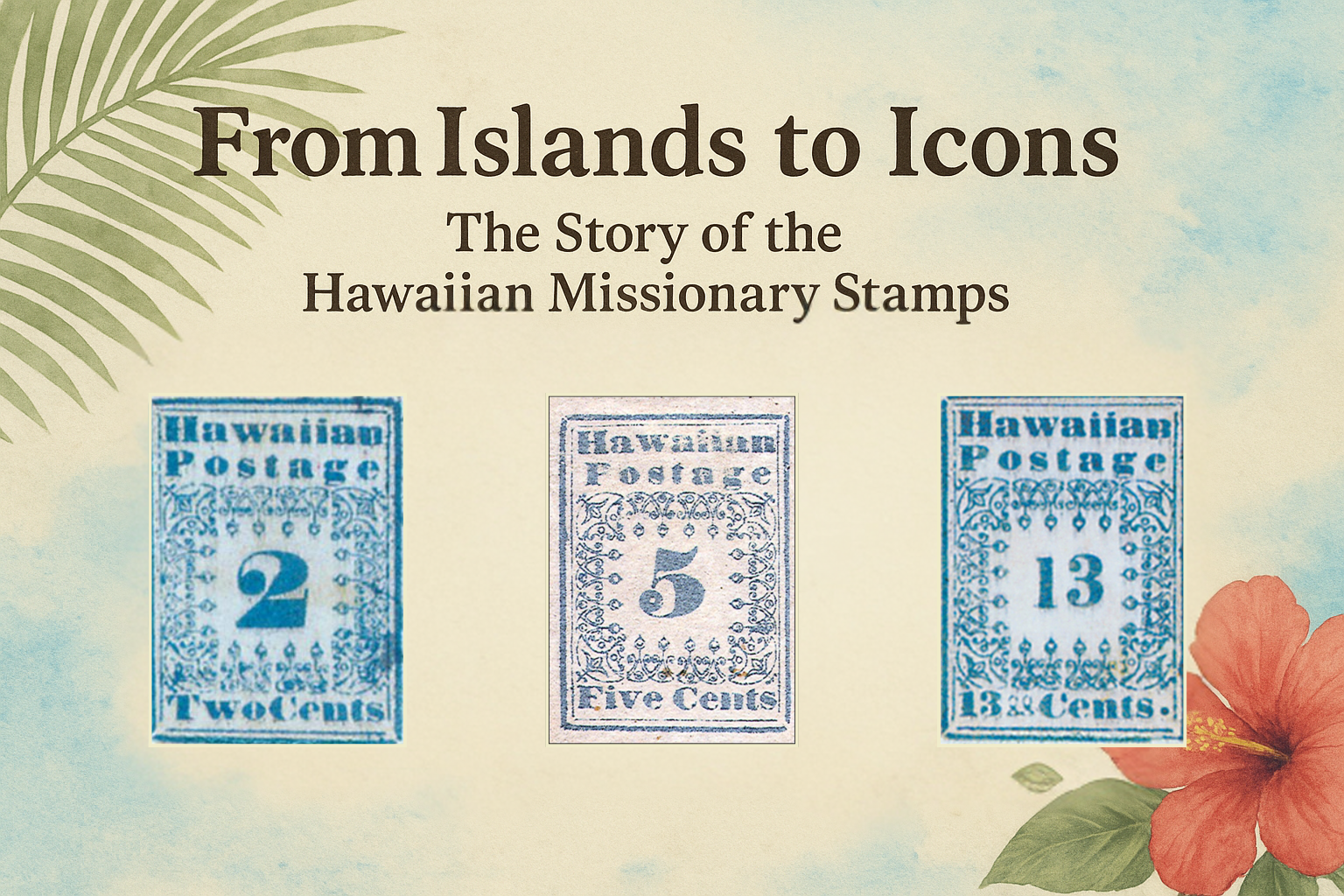From Islands to Icons: The Story of the Hawaiian Missionary Stamps
The three iconic “Missionaries”
The Dawn of Hawaiian Postage
In 1851, the Kingdom of Hawaii issued its very first postage stamps. Today remembered as the Hawaiian Missionaries, they are printed on fragile blue pelure paper. These stamps carried the mail of an island kingdom that, while geographically remote was becoming increasingly connected to the rest of the world.
Produced under the direction of Henry M. Whitney, Hawaii’s first postmaster (and son of missionaries), the stamps symbolized Hawaii’s entry into global communication networks. They were nicknamed “Missionaries” because most early letters franked with them were sent by Christian missionaries to families overseas.
The Designs
The Missionary stamps came in three denominations, each with a simple, utilitarian design:
2¢ Stamp – for newspapers and printed circulars
5¢ Stamp – for Hawaiian domestic postage and ship letters
13¢ Stamp – for mail sent all the way to the U.S. East Coast
Each featured a bold numeral in the center, framed by delicate borders and the inscription “Hawaiian Postage.”
The 2¢ Missionary (1851)
(Source: Smithsonian National Postal Museum)
The 2¢ Missionary is the rarest of them all. Only about 15 genuine examples are known to survive. Printed for newspaper postage, its survival rate is low because newspapers were rarely preserved.
The 5¢ Missionary (1851)
(Source: Smithsonian National Postal Museum)
The 5¢ Missionary was more widely used, often appearing on ship letters. Still, genuine examples are scarce and highly valued today.
The 13¢ Missionary (1851)
(Source: Smithsonian National Postal Museum)
The 13¢ Missionary was designed for long-distance mail: covering the full postage from Hawaii to the United States East Coast. It often bore the inscription “H.I. & U.S. Postage”, marking the cooperation between Hawaiian and U.S. postal systems. Surviving examples are rare and highly sought-after by collectors.
(Source: Smithsonian National Postal Museum)
Rarity and Legendary Sales
Because they were printed on such thin paper, most Missionaries were easily destroyed. Today, only around 200 Hawaiian Missionaries are known in total. Collectors consider them some of the greatest prizes in philately.
A rare cover known as the Dawson Cover, featuring a 2¢ Missionary, sold for $2.24 million in 2013.
Unused 2¢ Missionaries can fetch up to £450,000.
Even heavily damaged Missionaries are treasured due to their rarity.
The Controversy of the Grinnell Missionaries
In 1919, collector George Grinnell sold a group of 43 Hawaiian Missionary stamps. Later, experts deemed them forgeries; sparking one of the longest-running disputes in stamp collecting. While court rulings labeled them fake, modern forensic techniques have occasionally raised doubts, keeping the debate alive.
More Than Postage: What They Represent
The Hawaiian Missionary stamps are more than just collectibles. They tell a story of:
Connection – Hawaii’s effort to bridge the Pacific with reliable mail service.
Fragility – Thin paper, simple design, yet immense cultural weight.
Survival – Few survived, but those that did carry an almost mythical aura.
A Lettre Reflection
At Lettre, we see the Hawaiian Missionaries as symbols of why communication matters. These little blue slips of paper carried messages across oceans, connecting people separated by vast distances. They remind us that even the most fragile artifacts can carry stories powerful enough to last centuries.
Final Thoughts
The Hawaiian Missionaries embody the tension between fragility and endurance. They were never meant to last but their survival tells a story of love, faith, commerce, and connection. From a tiny Pacific kingdom, they became icons of global philately and proof that every letter carries more than words; it carries history.






